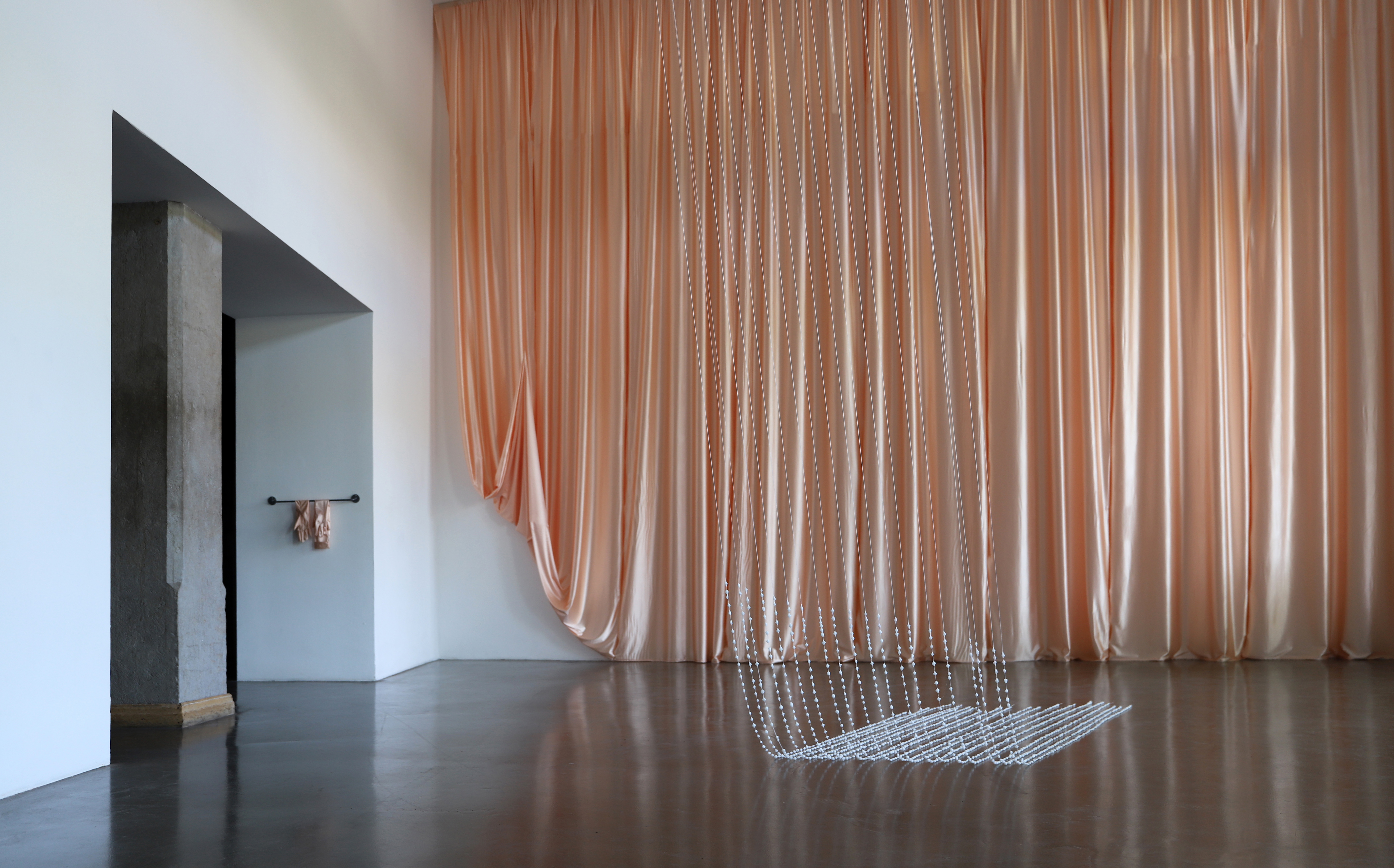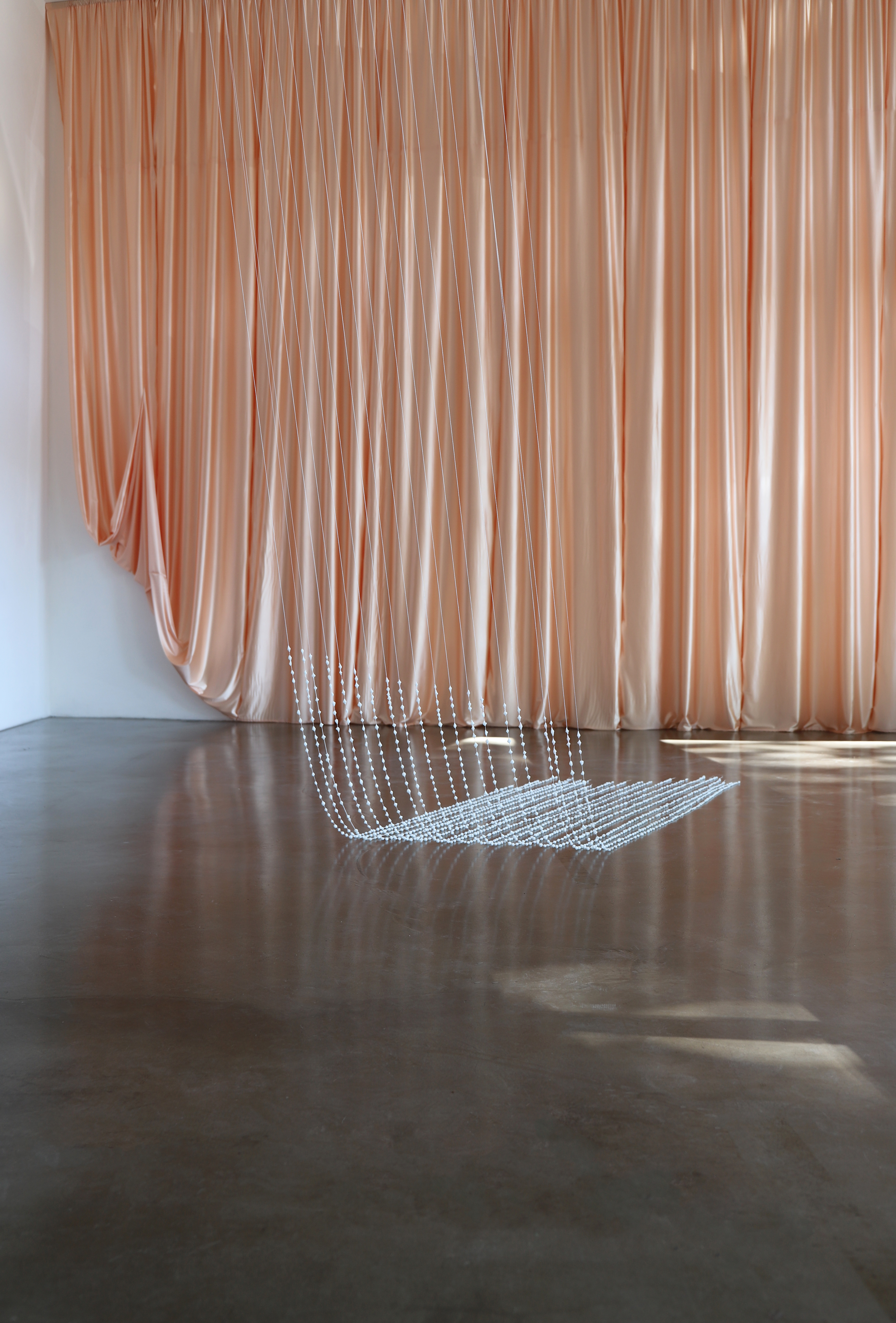What is on the other side of gold is the same as what is on this side / What is on the other side of gold is the same as what is on this side
2021
Tissu (rideau, gants), porte-serviette, env. 500 x 600 cm.Production La FB 15
Fabric (curtain, gloves), towel holder, approx. 500 x 600 cm.
Production La BF 15

What is on the other side of gold is the same as what is on this side, vue d’exposition : La Vie Oblique, La BF 15, Lyon, 2021
What is on the other side of gold is the same as what is on this side, , exhibition vue : La Vie Oblique, La BF 15, Lyon, 2021
What is on the other side of gold is the same as what is on this side, , exhibition vue : La Vie Oblique, La BF 15, Lyon, 2021
“ Composée d'un grand rideau en satin rose clair qui redouble un mur et d'une paire de gants confectionnés dans le même tissu et posés sur un portant en métal noir, cette œuvre met en abyme les questions de représentation.
Elle interroge en premier lieu le théâtre et ses représentations. Via l'usage d'un rideau d'abord, élément indispensable et central du pacte théâtral, qui sépare le réel de la salle de l'illusion de la scène. Pourtant, dans La vie oblique, le rideau n'ouvre que sur la présence creuse, plate et finie d'un mur blanc, que laisse paraître un pan soulevé. Via la présence adjacente de longs gants au repos sur leur barre ensuite, l'un cousu à l'endroit et l'autre à l'envers –diffraction inversée du même -, qui convoquent l'imaginaire des sorties bourgeoises du XIXème siècle.
Elle interroge également l'art visuel et ses représentations. Le rideau convoque la célèbre histoire de l'œuvre du peintre grec Parrhasius qui représentait de façon si trompeuse un drap recouvrant une peinture que son rival l'avait réellement pris pour un drap. Il s'inscrit également dans la tradition de la représentation du drapé, qui a donné à l'art occidental quelques-unes de ses sculptures et de ses peintures les plus remarquables.
What is on the other side of gold (…) est une pièce où, dans la suite des interrogations de Pline l'ancien ou de Clément Rosset, les questions phénoménologiques et ontologiques affleurent : qu'est-ce qui est vrai ? qu'est qui est réel ? qu'est ce qui se cache derrière tout rideau ? Est-ce que rien, ce n'est pas déjà quelque chose ?”
Sophie Kaplan, in Surface tendre, catalogue monographique, éd. FRAEM, 2022.
“Composed of a large
curtain in pink satin running along the wall as well as a pair of
gloves made in the same material which were laid upon a support in
black metal, this work is a mise en
abyme of certain questions of
representation.
Firstly, it examines
the theatre and its representations through the use of a curtain, an
indispensable and central element of the theatrical pact, that which
separates the reality of the room from the illusion of the stage.
However, in Oblique life,
the curtain merely opens onto the hollow, flat and finished presence
of a white wall, which is revealed by a raised panel. The adjacent
presence of the two long gloves resting upon their armature, one sewn
right side up and the other upside down – an inverted diffraction
of the same thing – conjures up the imaginary world of 19th century
bourgeois outings.
This work also questions
visual art and its representations. The curtain evokes the famous
story of the Greek painter Parrhasius who so deceptively represented
a draped cloth covering a painting that his rival actually took it
for a real one. It is also part of the art historical tradition of
representing drapery, which has given Western art some of its most
remarkable sculptures and paintings.
What is on the
other side of gold (...) is a play in
which phenomenological and ontological questions emerge, following
the enquiries of Pliny the Elder or Clément Rosset. What is true?
What is real? What is hidden behind every curtain? Is nothing not
already something?”
Sophie Kaplan, in Tender surface, Monograph, ed. FRAEM, 2022.



